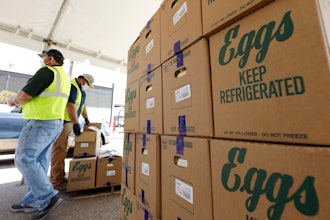FRESNO, Calif. (PRNewswire) — California's ripe olive growers have a significant impact on the state's economy, yielding nearly $493.6 million in annual economic activity – or nearly $1.4 million dollars each day of the year – as a result of grower spending, according to a newly released report commissioned by the California Olive Committee (COC) and conducted by Dennis H. Tootelian, Ph.D., Tootelian & Associates.
"California is the source for America's best ripe olives," said COC's Executive Director Alexander Ott. "The research clearly demonstrates the important role California ripe olive growers play in strengthening the economic climate of our state simply by doing what they love; growing the best olives for consumers."
The research found that about 3,555 jobs are created by growers as a result of their business activities and spending in a variety of farming and non-farming sectors. Additionally, more than $135 million in labor income is generated as a result of their activities. These are dollars going to wages and salaries for new employment as well as for the expanded incomes of those already in the labor force – a portion of which is reinvested throughout California's economy to pay for an array of goods and services.
The report states that nearly $14.7 million in tax revenue and other business licenses and fees are generated from the economic activity created by ripe olive growers, amounting to more than $40,000 each day of the year. Depending on how these funds are used, they can help pay for state and local programs that further benefit the communities where ripe olive growers live and work. For example, the business tax dollars ripe olive growers create could be used to help pay for nearly half of the California Wildlife Conservation Board's 2010-2011 fiscal budget.
The annual impact is based on an average year that was created by using historical and industrial operating statistics from the 2008 through 2010 production years. Olive trees are by nature an alternate-bearing fruit, meaning they produce a big crop one year and a smaller one the next. Therefore, an average year was created to account for variations in ripe olive crop revenues and expenditures due to fluctuations in production, climatic, pest, and other conditions.
"Even though we took a very conservative approach to measuring the olive grower data, the findings demonstrate how important a role California ripe olive growers play in strengthening the economic climate of California – touching nearly every aspect of life in the state," said Tootelian, who is also Director of the Center for Small Business at California State University, Sacramento.
Inputs for the study included grower surveys and interviews and industry statistics. That data came from sources such as the Census of Agriculture; U.S. Department of Agriculture; California Department of Food and Agriculture's California Agricultural Production Statistics 2010-2011; and, University of California Cooperative Extension's Sample Costs to Establish and Produce Table Olives.
All of the data was then analyzed through the IMPLAN model. The IMPLAN model examines economic relationships among businesses and between those businesses and consumers. Ultimately this impact analysis measures changes in economic variables on an entire economy.
The full economic impact report and related fact sheet can be found at www.calolive.org.
Editor's Note: It is important to recognize that this study understates the economic impact of the California ripe olive industry. Because there are only two processors of ripe olives in the state, financial statistics for these non-public companies were not obtained. Accordingly, this study focuses only on ripe olive growers and does not consider the economic impact of processors.
About the California Olive Committee
The California Olive Committee (COC) is a grower-funded program established by a Federal Marketing Order in 1965 to administer marketing, research, inspection and compliance programs on behalf of the ripe olive industry. The COC is comprised of two olive canners and thousands of family farmers, who raise olives on about 27,000 acres of orchards that crisscross the warm inland valleys of California.
About the California Ripe Olive Industry
California produces more than 95 percent of the olives grown in the U.S. today. Typically farms are not mechanically run, industrial farms, but multi-generational orchards powered by hardworking California farmers and their families. Plots come in all sizes – ranging from small 5-acre lots to 1,000-acre multi-crop farms – and are individually serviced by some of the finest stewards of the land with strict growing and handling standards. There are two main varieties of trees that produce California ripe olives: Manzanillo and Sevillano. These different varieties produce different sizes of olives, giving consumers a choice ranging from small to super colossal.






















